Author: James Berry
On the morning of Friday, May 6th we left the guest hotel at Tsinghua University and walked across campus to visit the Department of Engineering Physics. We first visited a classroom where undergraduate students were working on electronic design projects. We watched a presentation which discussed the value of electronic design for the products and systems of the future. Interestingly, the CAE software package they use is Altium Designer. This is the same package we use at the University of Michigan.
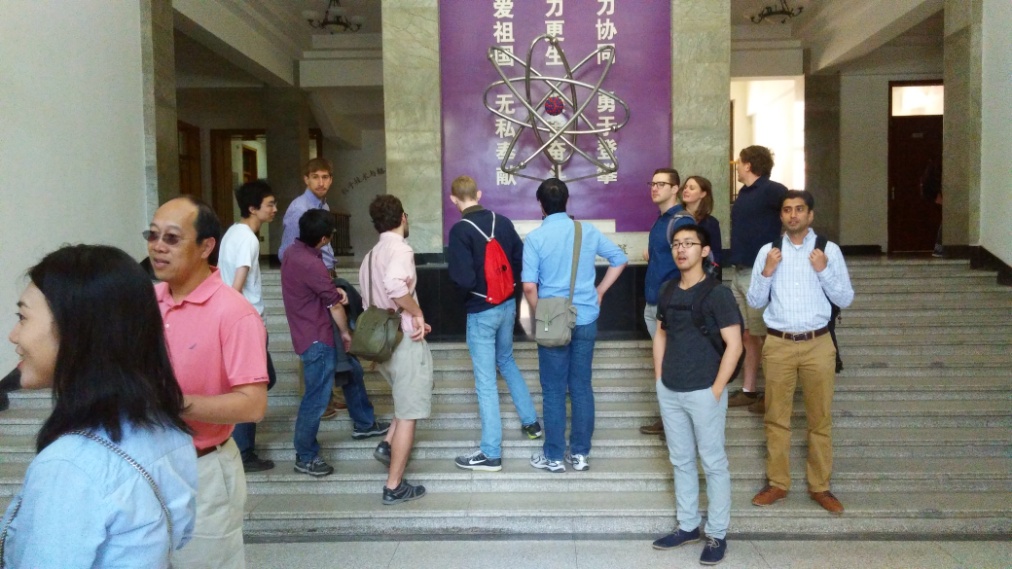
We next visited with Prof. Yi-kang Pu. His area of interest is plasma science. He described to us a class he teaches for undergraduates that allows them to become familiar with plasmas and build simple plasma based projects. I mentioned to him the Neon-Argon filled sculpture I purchased titled “The Phoenix”. It is mounted on an inductive driver, which can ionize the gas and produce interesting combinations of colored light. It also radiates a considerable amount of broadband RF energy, which can interfere with Wi-Fi and cell phone communications.
We were shown another project in the Engineering Physics Department, a spherical Tokomak that is being used to study the behavior of cold plasma. I stayed in this lab to get a photograph of the system and the Post-Doctoral researcher that worked with the it. As a result I became separated from the group and could not find them subsequently.
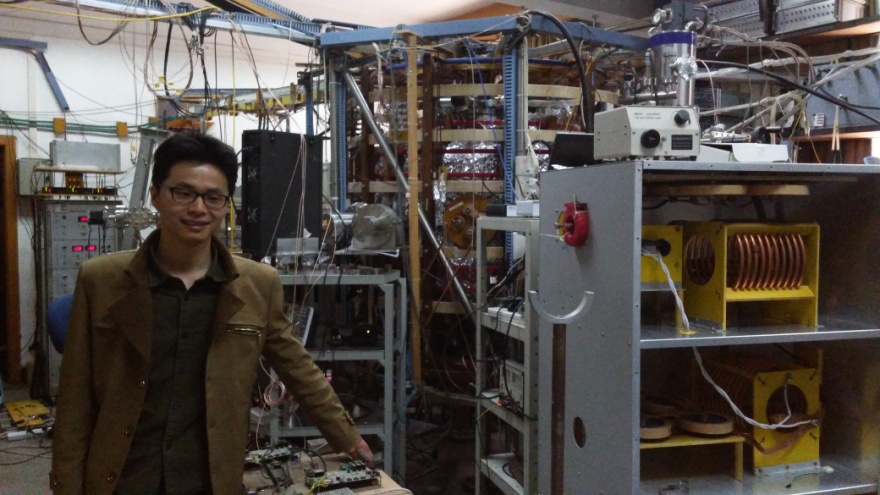
I wandered around the hallways on several floors of the building before going outside. They were not there either, and I did not know where we were to go next. I had noticed that a bus, which had been parked behind the building, had left and thought perhaps they were on it (not a likely possibility if I had thought about it at all deeply). In any case, after wandering about outside and inside the building for seven minutes or so, I finally gave up on finding them and went back to the guest hotel. I thought I would be able to contact Prof. He or perhaps Yuefeng Zhu on my cell phone. On the way back to the guest Hotel I was able to photograph the original Tsinghua Gate and the Grand Auditorium on the plaza that was the original Tsinghua campus.
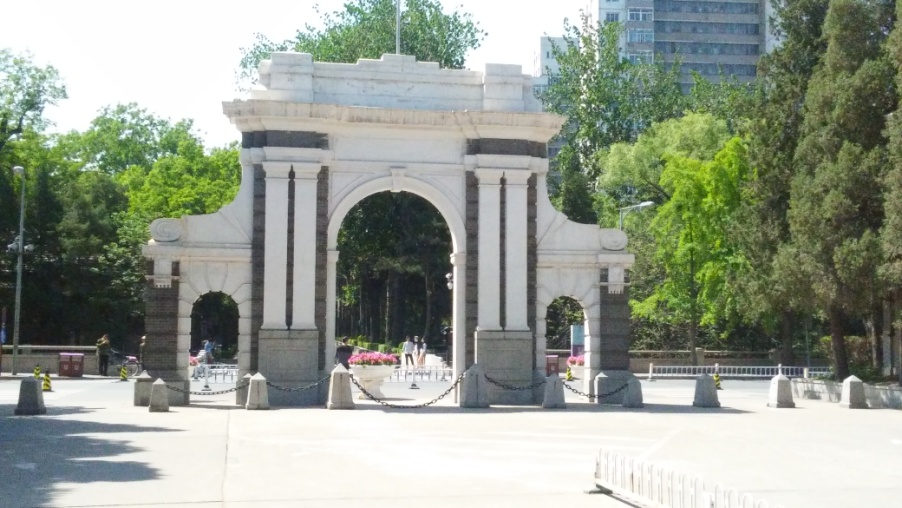

Back at the guest Hotel, I spoke with the person at the desk but they could not help me. I went to my room and tried to contact Prof. He, to no avail. The maid came and asked me if she could clean my room, so I went to the lobby. As I waited it occurred to me that I should visit the bathroom. I went to the lavatory near the dining room and discovered it wasn’t equipped with any western style toilets (sigh!). While I acquainted myself with the use of a traditional Chinese bathroom, the Tsinghua University student assistant who was assigned to our group called out my name. Prof. He had guessed I would return to the guest Hotel and sent the assistant to find me.
Following my rescue, we returned to the student dining canteen for lunch. We met the rest of our group there. They had been in a classroom when I lost them, after which they had gone to visit the accelerator lab, a short walk from the building we had been in. I was told that I would have enjoyed that part of the tour. The Lab included a fabrication shop with modern numerically controlled machine tools for making the electrodes and other components used in a particle accelerator. According to their web page, the Accelerator Lab at Tsinghua University is focused on the electron linear accelerators (linacs), and it isn’t surprising that they would concentrate on the details of the geometry of their designs. To quote the Engineering Physics Accelerator Lab web page:
The Accelerator Lab is engaged in research of low energy electron linac, accelerating structure, and beam dynamics.
The accelerator physics group is comprised of 3 full professors, 6 associate professors, 13 Ph.D. candidates and 17 master students. The lab offers courses for both undergraduate and graduate students, and has participated in writing and compiling a series of textbooks.
The lab participated in designing and manufacturing China’s first electron linac for medical applications, irradiation and dosage benchmarking. Besides the extensive research in S-band accelerator, the lab also devoted much efforts in designing and manufacturing C-band, L-band and X-band accelerators.
The lab’s goal is to construct an advanced center for low energy electron linac research, an advanced X-ray source based on Thomson scattering and an influential cradle for cultivation of qualified researchers in accelerator physics.
These people were the ones that designed the very compact electron linacs which we had seen at Nuctech. According to members of our group, they also have an Inverse Compton accelerator and a proton accelerator. Apparently the web page is not up to date. I was not familiar with an Inverse Compton accelerator, so I looked online and found a description of the process in the Wikipedia article on Compton Scattering:
Some synchrotron radiation facilities scatter laser light off the stored electron beam. This Compton backscattering produces high energy photons in the MeV to GeV range[7] subsequently used for nuclear physics experiments.
Inverse Compton Accelerators produce Gamma-Ray photons; perhaps we should build one.
After lunch we boarded individual cars and drove to the headquarters of Sohu. This is a Chinese internet media conglomerate that was started by Dr. Charles Zhang, a classmate of Prof. He at Tsinghua University. Dr. Zhang founded this organization after completing a doctoral program at MIT in the early 1990’s.
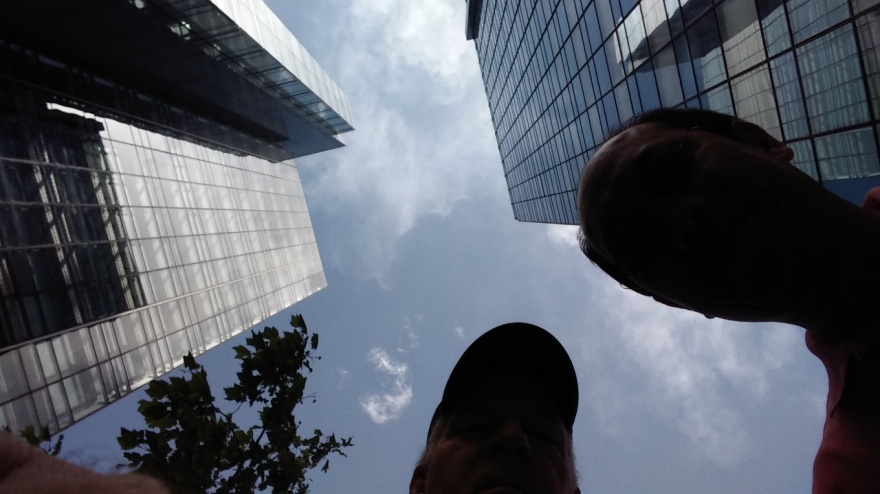
It is very similar to Yahoo Inc., and like Yahoo is worth in excess of 1.5B dollars. We met Dr. Zhang, spoke with him briefly in his penthouse office and took several pictures with him.
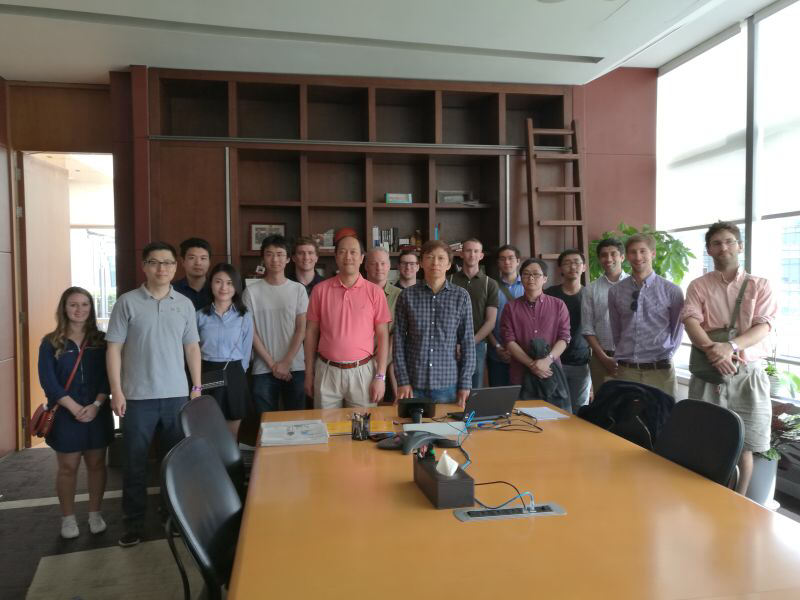
Afterwards we listened to a presentation by a staff member at Sohu which provided some background on the company and business activities. The organization has four divisions: Media, Video content, Search and Games. The search engine part of the business is handled by Sogou, a wholly owned subsidiary. Interestingly, one of the most popular products of Sogou is the Pinyin convertor, an online tool which converts traditional Chinese characters into a phonetically equivalent meaning using a Romanized alphabet. There is another company called Changyou (also a wholly owned subsidiary) that is responsible for gaming. Afterwards we were given a tour of the offices, ending with a visit to the gift shop.

We got back into the cars and drove to Beijing University. It is actually called Peking University, which is the old spelling. This small piece of confusion was nothing to be concerned about for us who do not (yet) speak Mandarin Chinese. Our group made individual and collective attempts to acquire various words or phrases in Mandarin, but on the whole most of us were lost.
At Beijing University we were taken on a tour by Weiyi Wang, an employee of H3D and a PhD graduate from the Orion Research group. We walked around for the remainder of the afternoon. We learned that this campus was established in the aftermath of the first Sino-Japanese War, during the Hundred Days of Reform in 1898. It occupies a site which had formerly been the Imperial Academy, and before that had been an Imperial Garden; it is smaller than the campus of Tsinghua University. It was explained to us earlier in the trip that “Tsinghua is like the M.I.T. of China, but Peking University is the Harvard of China”. It was hard to know what to expect based on that comparison, but what we saw was a large and beautiful campus spread across a rolling terrain. Weiyi was happy to show us several places including Weiming Lake and the Boya Pagoda.

We saw many of the buildings on this campus, but not all of them. It may not be as large a campus as Tsinghua, but it is still a very large campus! At one point Weiyi mentioned that the campus had been more than an Imperial Garden – it had been built originally as a residence for a Princess of the Qing Dynasty. Weiyi went on to explain the significance of the studs that were used to decorate the doors on the gates of Imperial grounds. The Emperor was at the top of the hierarchy, and so was represented by the number nine. Other member of the royal family would be assigned numbers commensurate to their rank. The studs on the gateway doors to Peking University had a pattern of five columns by seven rows, consistent with the status accorded to a Princess (also consistent with Weiyi’s version of history).

Afterwards we returned to the campus of Tsinghua University and had dinner at a different student canteen. It had been a very full day of site seeing.
